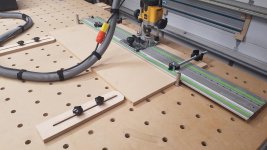rmwarren
Member
- Joined
- Jul 11, 2010
- Messages
- 3,063
I have a spring project to finally finish the closet, which will entail making ~40 panels w/32mm line boring. Also going to use French cleats, but that's a separate topic. The panels will mostly be 16" nominal, with some 24" lowers and possibly some 12" in one area. Industrial Plywood in Reading PA sells precut white birch 8' panels that have one edge banded, which are perfect. Partially complete design:
[attachimg=1]
I have the LR 32 setup with a 1010, love the router guide/rail but always disliked the stops and alignments arms gadgets. Not that I do a lot of 32mm cabinets, but every time I do I end up fiddling with the setup to frustration. What I wanted was a stationary, adjustable setup that I can turn over to my "assistant" (SWMBO) while I focus on routing cleats, etc. Anyway, this is where things stand so far (proof-of-concept):
[attachimg=2]
[attachimg=5]
[attachimg=8]
Using Woodpeckers Super Track and the 8020 extension arms I printed an adjustable 6mm pin thingy and an edge stop that both spaces the offset to the pins and locates the panel to be bored. We were snowed in this weekend, so Fusion/3D printer…
[attachimg=3]
The track attaches to the extension arms with 1/2 by 1-12" AL bar stock, slides anywhere along the arms and a knob locks it down.
[attachimg=4]
My plan is to make balanced panels in increments of 32mm. The spacer/stops offset from the pin so the panel end is 96mm from the pin centerline. One screw attaches the stop with a tee nut, the other hole is threaded and the screw acts as an adjuster in case the panels lengths end up slightly
[attachimg=1]
I have the LR 32 setup with a 1010, love the router guide/rail but always disliked the stops and alignments arms gadgets. Not that I do a lot of 32mm cabinets, but every time I do I end up fiddling with the setup to frustration. What I wanted was a stationary, adjustable setup that I can turn over to my "assistant" (SWMBO) while I focus on routing cleats, etc. Anyway, this is where things stand so far (proof-of-concept):
[attachimg=2]
[attachimg=5]
[attachimg=8]
Using Woodpeckers Super Track and the 8020 extension arms I printed an adjustable 6mm pin thingy and an edge stop that both spaces the offset to the pins and locates the panel to be bored. We were snowed in this weekend, so Fusion/3D printer…
[attachimg=3]
The track attaches to the extension arms with 1/2 by 1-12" AL bar stock, slides anywhere along the arms and a knob locks it down.
[attachimg=4]
My plan is to make balanced panels in increments of 32mm. The spacer/stops offset from the pin so the panel end is 96mm from the pin centerline. One screw attaches the stop with a tee nut, the other hole is threaded and the screw acts as an adjuster in case the panels lengths end up slightly
Attachments
-
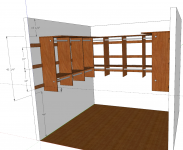 Closet.png416.7 KB · Views: 1,428
Closet.png416.7 KB · Views: 1,428 -
 Table.png8 KB · Views: 1,382
Table.png8 KB · Views: 1,382 -
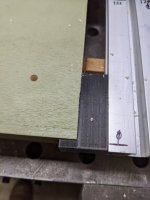 PXL_20220131_000210731.jpg238.9 KB · Views: 1,367
PXL_20220131_000210731.jpg238.9 KB · Views: 1,367 -
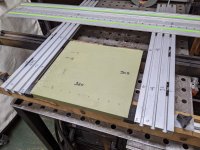 PXL_20220131_000328593.jpg317.1 KB · Views: 1,435
PXL_20220131_000328593.jpg317.1 KB · Views: 1,435 -
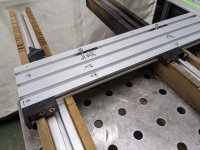 PXL_20220131_000558651.jpg314 KB · Views: 1,323
PXL_20220131_000558651.jpg314 KB · Views: 1,323 -
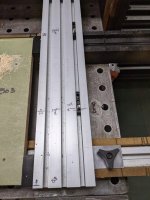 PXL_20220131_000237103.jpg102.4 KB · Views: 1,351
PXL_20220131_000237103.jpg102.4 KB · Views: 1,351 -
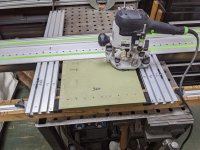 PXL_20220131_000151552.jpg315.8 KB · Views: 1,421
PXL_20220131_000151552.jpg315.8 KB · Views: 1,421 -
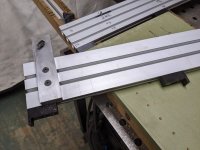 PXL_20220131_000735176.jpg254.6 KB · Views: 1,343
PXL_20220131_000735176.jpg254.6 KB · Views: 1,343 -
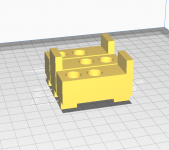 Stops.png255.8 KB · Views: 1,331
Stops.png255.8 KB · Views: 1,331 -
 PXL_20220131_000300937.jpg313.7 KB · Views: 1,419
PXL_20220131_000300937.jpg313.7 KB · Views: 1,419

